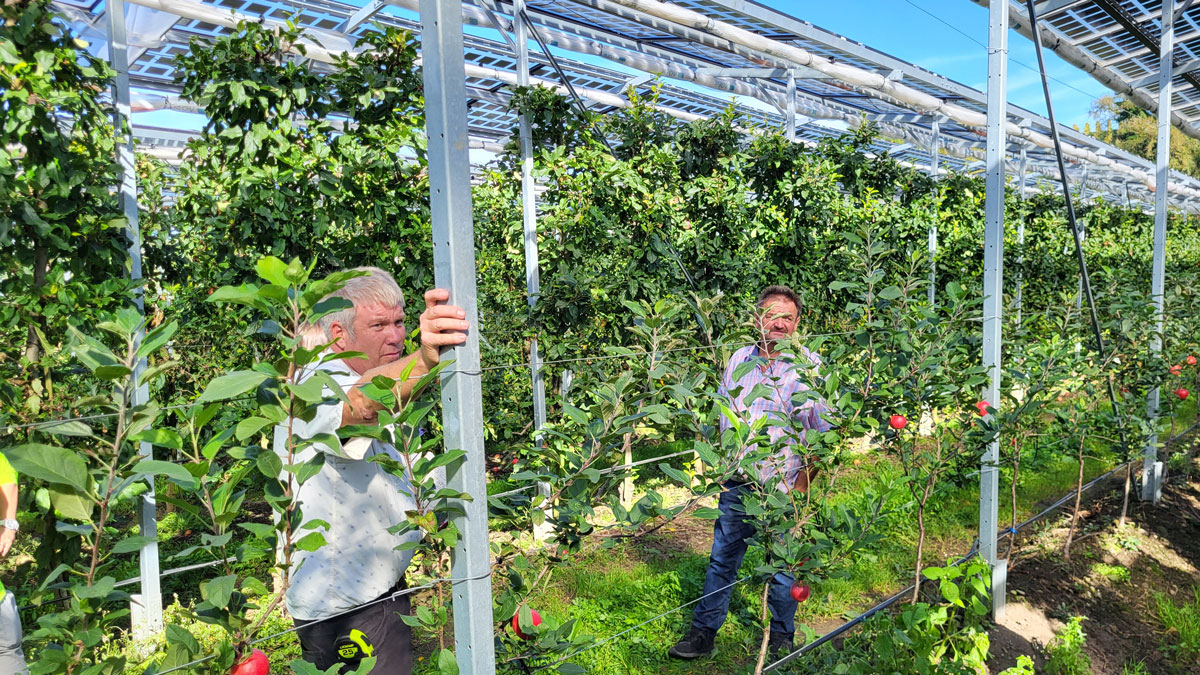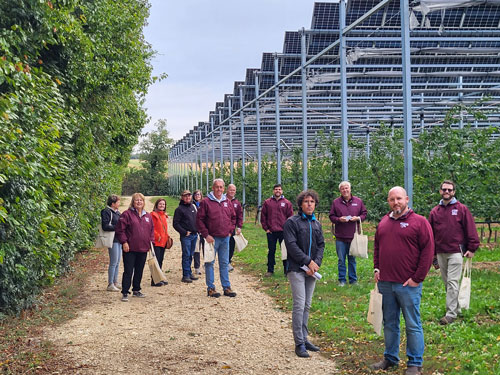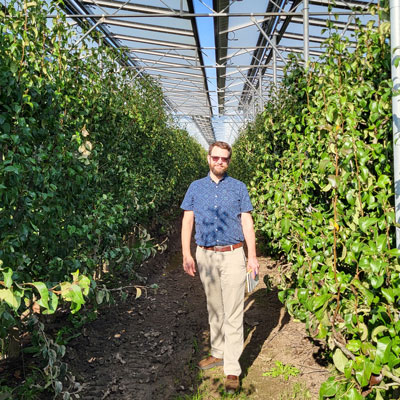
Southern Illinois farmer and orchardist Wayne Sirles, president of Rendleman Orchards in Alto Pass, left, and German orchardist Hubert Bernhard discuss growing apples under solar panels on Bernhard’s orchard in Kressbronn, Germany.
November 07, 2023
SIU-led delegation explores getting crops and solar energy from the same plots
CARBONDALE, Ill. – Humans need energy almost as much as they need food. A team from Southern Illinois University Carbondale is helping explore ways to harvest both from the same plots of ground.
SIU’s Advanced Energy Institute recently led a delegation, including technical experts, labor leaders, elected state officials and local farmers, to Europe, where they toured agrivoltaic facilities. Agrivoltaic systems refer to the practice of locating solar energy collection stations and farming operations on the same land, essentially, growing crops beneath solar panels.
The practice comes with benefits as well as challenges. On the plus side, solar panels protect the crops from hazards such as hail and frost, and reduce the plants’ water requirements by providing shade when it is needed during the hottest part of the day, all while producing electricity. The panels also reduce the need for pesticides and other chemicals by reducing stress on the plants grown underneath.
Challenges include carefully planning such operations to work in harmony with crop systems, as well as finding ways to work with the agriculture community to show the potential benefits. The trip by the delegation, which included Southern Illinois orchardists and winemakers, went a long way toward educating all involved, said Ken Anderson, director of the Advanced Energy Institute at SIU.
“The idea of agrivoltaics has been around for a while now, but it has really taken off in the last few years, especially in Europe,” Anderson said. “By using the land for two purposes, you can realize more value than you can using it for a single purpose, even if you have to make modest compromises for both the farming and the energy production. That sounds simple enough, but translating that to practice requires balancing a lot of competing factors, and that work is really just gathering steam.”
Southern Illinois a good fit
European developers have been leading the agrivoltaic effort, Anderson said, and are about 10 years ahead of the United States. During its two-week visit in October, the delegation toured 15 sites, including small research facilities and commercial farms producing apples, pears, apricots, grapes and other crops beneath solar panels.
 Agrivoltaic systems especially make sense for Southern Illinois for several reasons, Anderson said, one of which is the region’s large number of orchards and vineyards.
Agrivoltaic systems especially make sense for Southern Illinois for several reasons, Anderson said, one of which is the region’s large number of orchards and vineyards.
About 80% of Illinois’ orchards are located south of Mount Vernon, and the numbers are similar for vineyards. The economics of agrivoltaics work well when applied with those sorts of crops, Anderson said, adding that it’s much more difficult to make the economics work over broad acreage crops such as corn and soybeans.
“The sites we visited grow the types of high-value specialty crops we grow here in Southern Illinois, and that’s why we went to meet those developers and tour some of their projects,” Anderson said.
Growing need
Another good reason to consider agrivoltaic systems in Southern Illinois is its high amount of natural sunshine as opposed to wind energy, which has become a heavy investment in the central and northern parts of the state. The region south of Springfield also is facing an electrical generating shortage, with up to half of its coal-fired powerplants either having been retired or facing shutdown within the next five years.
“We need ways of sustainably generating that electricity that help us manage those needs and those costs,” Anderson said. “Agrivoltaics can potentially provide that, while also creating a significant new long-term asset for the university that would benefit and create opportunities for our students and faculty.”
Managing the variables
During the trip, the team chose sites with the best current systems, meeting their leading researchers and developers as well. Along with choosing sites growing crops like those in Southern Illinois, the group also tried to include sites testing different approaches to balancing the competing variables for power and agriculture.
 Some technical details come down to how to share sunlight between two things – solar panels and plants – that both need it. Several approaches are available, Anderson said, including using semi-transparent solar panels that allow light through for the plants or using so-called “tracker panels” that can rotate to capture more or less solar energy but are configured to allow more or less light through to the plants as needed.
Some technical details come down to how to share sunlight between two things – solar panels and plants – that both need it. Several approaches are available, Anderson said, including using semi-transparent solar panels that allow light through for the plants or using so-called “tracker panels” that can rotate to capture more or less solar energy but are configured to allow more or less light through to the plants as needed.
“Each strategy has pros and cons and getting that balance right is a big part of what we were looking at while we were there,” Anderson said.
SIU can play major role
The push for renewable energy systems, such as wind and solar farms, has sometimes resulted in tensions between agricultural and electrical-generating interests, Anderson said. In some cases, access to prime farmland has come into conflict with such projects, resulting in suspicion between the two sides of the issue.
That was one reason Anderson included local farmers on the trip.
“They knew the right questions to ask from the farmer’s perspective, and I think it’s fair to say that they were impressed by what they saw,” he said.
With its energy and agricultural expertise, SIU is perfectly positioned to blaze a trail in agrivoltaic technology and systems and prove crop and power production can exist in harmony and mutual benefit, said Anderson, who hopes to spearhead a university effort to build an agrivoltaic system to demonstrate the concept locally. Not only could the project help the university meet its own power needs, but it would also demonstrate the concept’s workability and robustness to farmers, who are often necessarily skeptical of major changes.
“Farming is hard, and the returns aren’t always great as it is. So, before they commit to anything new, especially something that requires a lot of investment and a long-term commitment of their land, farmers want to see it working, here, locally in our climate and with our soils and our crops,” Anderson said. “SIU can be that demonstration. We can lead the way and show what’s possible.”
Photo captions: (Middle) Members of the Southern Illinois delegation and some of their French counterparts visit the experimental agrivoltaic peach orchard developed by French developer Sun’Agri and the Station d’Expérimentation Fruits Auvergne-Rhône-Alpes, near Valence, France. (Bottom): SIU senior engineer Justin Harrell explores an experimental pear orchard operated by Wageningen University as part of the Dutch Sunbiose project in the Netherlands. (Photos provided)
